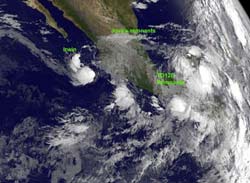Satellites view 3 dying tropical systems in eastern Pacific

This GOES-11 satellite image from Oct. 13 at 8 a.m. EDT, shows Tropical Depression Irwin is still at sea (left), remnants of Jova are over southwestern Mexico, and Tropical Depression 12E was inland over southeastern Mexico. TD12E's cloud cover extends over the Yucatan Peninsula, Belize and Guatemala. Credit: Credit: NASA/NOAA GOES Project<br>
NASA's Aqua satellite passed over the eastern Pacific at 4:41 a.m. EDT, Thursday, Oct. 13, and captured an infrared image of Tropical Depression Irwin still in open waters and the remnants of post-tropical cyclone Jova inland over central Mexico. Irwin still had some strong convection (rapidly rising air that condenses and forms thunderstorms that make up a tropical cyclone) in a very small area, while all of the punch (strong convection) was now missing from post tropical cyclone Jova. Cloud top temperatures in Irwin were still near -63F/-52C in that small area of strong convection, while cloud tops in Jova have warmed and weakened.
That small area of disorganized convection seen in the AIRS image is enabling Irwin to still be classified as a tropical depression. The National Hurricane Center noted today that “the system is on the verge of losing the convective requirement of a tropical cyclone, and Irwin is expected to become a remnant low within 24 hours.”
At 5 a.m. EDT today, Oct. 13, Irwin's maximum sustained winds were near 35 mph (55 kmh). It was located about 230 miles (365 km) west-southwest of Manzanillo, Mexico near 18.3 North and 107.7 West. Irwin was moving to the northeast near 13 mph (20 kmh) and is expected to curve to the east then southeast, heading back toward the open ocean, where it is expected to fizzle out.
The remnants of post-tropical cyclone Jova dissipated over central Mexico. At 11 p.m. EDT last night, Oct. 12, the last known center of Jova was near 21.7 North and 104.2 West. At that time, Jova had maximum sustained winds near 25 knots (30 mph). By 10 a.m. EDT on Oct. 13, Jova's remnants were dissipating. Skies over Mazatlan, Mexico were mostly clear, however there were some towering cumulus clouds observed. Further south at Zacatecas Airport, Mexico, mostly cloudy skies prevailed. On the west coast, Puerto Vallarta reported overcast skies with some light drizzle.
During the morning (EDT) on Oct. 13, Tropical Depression 12E was inland over southeastern Mexico, including the Yucatan Peninsula, Belize and Guatemala. It TD12E is now a broad area of low pressure and was seen on NOAA's GOES-11 satellite imagery. The GOES-11 satellite image was created by NASA's GOES Project at the NASA Goddard Space Flight Center in Greenbelt, Md. It showed that TD12E's clouds extended from southeastern Mexico eastward into the northwestern Caribbean Sea. The National Hurricane Center currently gives TD12E a “near zero percent” chance of regenerating.
Meanwhile, it is generating disorganized showers and thunderstorms. Some of those thunderstorms contain heavy rainfall over southeastern Mexico, the Yucatan, Belize and Guatemala.
Media Contact
More Information:
http://www.nasa.govAll latest news from the category: Earth Sciences
Earth Sciences (also referred to as Geosciences), which deals with basic issues surrounding our planet, plays a vital role in the area of energy and raw materials supply.
Earth Sciences comprises subjects such as geology, geography, geological informatics, paleontology, mineralogy, petrography, crystallography, geophysics, geodesy, glaciology, cartography, photogrammetry, meteorology and seismology, early-warning systems, earthquake research and polar research.
Newest articles

Silicon Carbide Innovation Alliance to drive industrial-scale semiconductor work
Known for its ability to withstand extreme environments and high voltages, silicon carbide (SiC) is a semiconducting material made up of silicon and carbon atoms arranged into crystals that is…

New SPECT/CT technique shows impressive biomarker identification
…offers increased access for prostate cancer patients. A novel SPECT/CT acquisition method can accurately detect radiopharmaceutical biodistribution in a convenient manner for prostate cancer patients, opening the door for more…

How 3D printers can give robots a soft touch
Soft skin coverings and touch sensors have emerged as a promising feature for robots that are both safer and more intuitive for human interaction, but they are expensive and difficult…




















